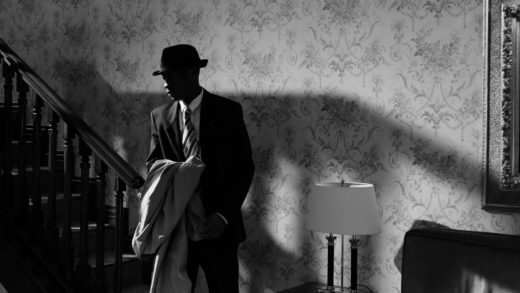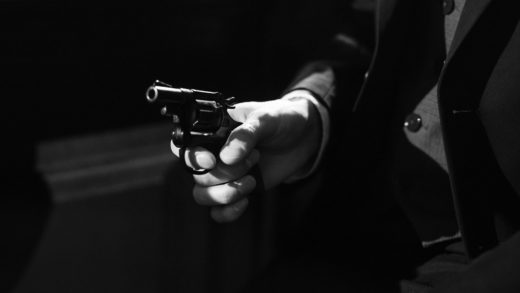
For a little while, in the early 2000s, there was a tendency to put out commercials and music videos which looked like they’d been shot in log and broadcast almost untouched. Let’s be clear that this absolutely never happened because anyone had got the wrong idea about how hypergamma worked on Sony HD cameras of the time. Obviously, if that were true, it’d mean that quite a lot of advertising executives were guilty of jumping on a creative bandwagon they barely understood, and nobody in the commercial arts would ever do that. Either way, the unprocessed-log look is a conspicuous exception which proves a very rough and general rule: for a long time, many of the world’s most-liked pictures have been daringly full of contrast.
This line of thought is provoked by a contradiction which exists in camera technique now. On one hand, there’s a raucous cheer every time a manufacturer manages to squeeze another stop out of a sensor. On the other, lots of people like John Alton, and his tendency to leave lots of the silver in prints of his monochrome noir classics. It’s too easy, sometimes, to throw both of those things – high dynamic range, and rich, contrasty images – into the same vague brain bin that contains words like “cinematic,” “painterly,” “organic,” and other terms that ought to attract an immediate donation to some sort of cinematographic swear jar.
Escaping the swear jar
Of course the reality is that “rich blacks” and “high dynamic range” are, to some extent, opposing concepts.
Let’s be clear we’re not talking about HDR displays, here, which are designed to solve exactly this problem by the brute force approach of making the highlights really, really bright, and the shadows really, really dark, so that we can shoot on billion-stop cameras and not have to throw away all that dynamic range before it collides with the audience’s corneas. We’re talking about cameras, which, until further notice, are likely to be used to target standard dynamic range results at least as much as anything else.
So at some point, more contrast and more dynamic range are two opposing forces. Because they both sound nice, we have decided we’d like to have both at once anyway. As a result, the first creative node in an awful lot of Resolve trees consists of an S-curve which looks like an elevation map of a skate ramp. It is intended to sweep lots of the camera’s hard-won dynamic range under the rug in search of pictures with a bit of bite

Held in the log
Or, at least, that’s the way it works in the minds of people who might switch off the LUTs on an on-set monitor and say something like “well, it’s held in the log.” That’s long been an acceptable way to Teflon-desk a lighting problem down to post production, and it’s often fine. Most of the people who tickle the trackballs for a living are more than happy to earn a warm handshake from the director of photography after knocking down on a troublesome sky.
When said troublesome sky is a couple of stops too hot, that works quite well. When it’s seven stops too hot, as is increasingly possible, it’s a little bit more difficult to lift-gamma-gain our way out of the problem, at least if we don’t want the result to look like an early-2000s, tone-mapped HDR still.
(Actually, has anyone ever done that look in motion?)
Photons by the bucketful (and less contrast)
Probably the bigger problem, though, is what happens when less-experienced people get their hands on a camera that collects photons by the bucketful. Yes, it’s possible to make tremendous errors of exposure and get away with it, and it’s increasingly possible to light night exteriors by goading a couple of glow-worms into a mating frenzy and crazy-gluing them to a stick. To indulge in a bit of middle-aged fist-shaking, we might ask whether that sort of power is actually a worthwhile formative experience for a film school beginner, but that’s not the only issue.

The issue with huge dynamic range on a student short is that one of the actors might fire a flashlight into the face of the other at point blank range. In that situation, it’s too easy to recite the incantation it’s held in the log and end up needing a grade that’s some way beyond the undeveloped pixel-poking abilities of someone new to Resolve.
In principle, it’s become even easier to turn out Altoneseque noirs with blacks so solid you can cut them into chunks and sell them on eBay. Throw a LUT into a monitor, and anyone can shoot a virtual equivalent of Tri-x pushed two. It’s a much easier way to greater consistency than anyone has ever had access to in the past. The roadblock is pulling it off without falling foul of it’s held in the log.
Well, that, and the sheer creative daring to make it happen. We’ve conditioned a generation of beginners to prize dynamic range and to maintain it at all costs. Driving the highlights of a scene into white is not something people are instinctively inclined to do, even though controlling the transition to white is exactly what all that extra dynamic range is for in the first place. The idea that it’s normal to deliberately throw away picture information is not entirely new – we’ve had log for years – but as cameras get better, doing that will go from normal to essential.

Filmtools
Filmmakers go-to destination for pre-production, production & post production equipment!
Shop Now













